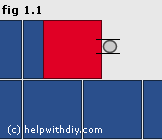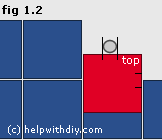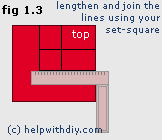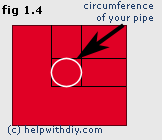
How to cut tiles around pipes when kitchen or bathroom tiling |
 |
Welcome to the seventh part of our tiling guide.
This page describes how to mark and cut around pipes in the kitchen or bathroom.
continued from: Part 6
|

|
This page is © Copyright 2001-2014 helpwithdiy.com |
|

Please note: We will accept no responsibility for any damage or injury as a result of following this guide.
For further information please see our disclaimer, a link to which can be found at the bottom of this page.
|


|
When working with ceramic tiles always wear safety goggles and thick work gloves! Ceramic tiles can be extremely sharp when trimmed or cut.
|
|

How to cut around pipes |
When tiling your bathroom or kitchen there is a good chance you will come across a pipe or two! To cut a tile around a pipe is not as difficult as it may seem, with a little practice you will be cutting tiles in no time.
There are several ways to achieve a similar result, your choice of technique will depend on what tools you have at your disposal and your current DIY skill level.
note: do not apply tile adhesive until you have cut and tested the position of the tile against the pipe. Tile adhesive becomes unusable after a short time.




|
1. Position the tile as shown in fig 1.1 (tile of interest shown in red). Ensure it is aligned correctly using the other tiles as a guide (don't forget to take into account the tile spacer on the top of the row of tiles below).
2. Using your felt-tip or pencil mark the tile twice, once level with the top of the pipe and once level with the bottom of the pipe (see fig 1.1).
3. Next align the tile as shown in fig 1.2. Line it up with the tile in the row below it, leave enough room for a spacer between it and what will be the neighbouring tile.
4. Mark the tile as before except make vertical marks inline with the left and right of the pipe.
5. Mark the top of the tile so you know which way up it will eventually go.
6. Using your set-square lengthen and join the lines as shown in fig 1.3. This will give you a square which will be the diameter of the pipe.
7. The next step is to draw the circle which will be the circumference of the pipe (fig 1.4). There are a few ways to achieve this, the easiest being to use an off-cut of the pipe that you are tiling around. If an off-cut is not available you could use a compass to draw the circumference of the pipe. Remember that you want to leave a small gap (around 5mm) between the pipe and the tile, which will be grouted.
8. The next stage is to cut out the circle from the tile, there are several ways to do this.
One way is to drill the tile several times within the circle and then use a tile saw and tile-file to trim the inside of the circle until you have the desired circumference. (this option is only suitable when the tile can be slid over the pipe)
Another option is to cut the tile horizontally into two pieces, with the cut going straight through the centre of the circle. After cutting, use the tile saw to remove the excess tile.
You can use a tile file to perfect the circular cut, when you are happy with the cut, the next step is to position the tile (or two pieces of tile depending on which option you chose to cut the tile).
|
When you are satisfied that the tile fits nicely around the pipe, apply tile adhesive either to the surface area or the back of the tile (whichever you find easier). Firmly place the tile into position and remove any excess adhesive from the face and edges of the tile.
|

|
In part 8 we will show you how to cut around light switches and electrical sockets (points/outlets).
|


|
|
|
